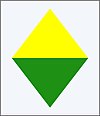South African 1st Infantry Division
| 1st South African Infantry Division | |
|---|---|
| Active | 13 August 1940 – 1 January 1943 1 July 1948 – 1 November 1949 |
| Country |
|
| Allegiance | Allied forces of World War II |
| Branch |
|
| Type | Infantry |
| Size | Division |
| Major battles |
Battle of El Yibo Battle of Mega Siege of Tobruk Battle of Gazala Battle of Mersa Matruh First Battle of El Alamein Battle of Tel el Eisa Second Battle of El Alamein |
| Disbanded | 1 January 1943 |
| Commanders | |
| First Commander | From 13 August 1940: Brigadier George Brink |
| Subsequent Commander | From 10 March 1942: Major General Dan Pienaar |
| Insignia | |
| Identification symbol |
 |
The 1st South African Infantry Division was an infantry division of the army of the Union of South Africa. During World War II the division served in East Africa from 1940 to 1941 and in the Western Desert Campaign from 1941 to 1942. The division was disbanded on 1 January 1943, for conversion into what would become the 6th South African Armoured Division. The division was also briefly active after the war from 1 July 1948 to 1 November 1949.
When Neville Chamberlain declared war on 3 September 1939, the Union Defence Force consisted of 5,385 Permanent Force members, 14,631 Citizen Force members and 122,000 Commandos of which only 39,000 were considered suited for field deployment. The Defence Act also prohibited the deployment of its members beyond the confines of southern Africa. On 4 September, General Hertzog resigned and was replaced by General Smuts – and two days later, on 6 September South Africa declared war against Germany.
The “phoney war” luckily granted more time and by 22 September a policy paper had been submitted calling for the formation of two “Forces” and was approved in mid October, laying the foundations for the formation of 1 and 2 SA Divisions. In March 1941, fearing the Italian commitment to war, General Wavell requested the services of a South African Brigade Group in Kenya via the Imperial General Staff. Prime Minister Smuts consented.
Initially, to circumvent the limitations of the South African Defence Act (Act No 13 of 1912), only volunteers were recruited and they were subject to an oath on induction whereby they consented to being deployed anywhere in Africa, this being a pre-requisite for acceptance into the Union forces. Men who attested under these terms were entitled to wear the distinct insignia of the Mobile Field Force, a red / orange shoulder strap which was to become known as the "Red Tab". The Defence Act was later amended.
...
Wikipedia
